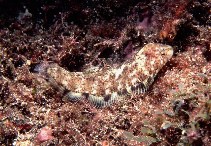| Family: |
Cynoglossidae (Tonguefishes), subfamily: Symphurinae |
| Max. size: |
7.98 cm SL (male/unsexed) |
| Environment: |
demersal; marine; depth range 3 - 23 m |
| Distribution: |
Eastern Atlantic: Azores, Madeira, Canary, Cape Verde Islands and Senegal. |
| Diagnosis: |
Dorsal spines (total): 0-0; Dorsal soft rays (total): 80-87; Anal spines: 0-0; Anal soft rays: 66-72; Vertebrae: 45-48. a 1-3-2 interdigitation pattern; 12 caudal fin rays; 80-87 dorsal fin rays; 66-72 anal fin rays; 45-48 total vertebrae; 84-98 scales in a longitudinal series; unpigmented peritoneum; unique ocular side pigmentation featuring a yellowish to dark brown background with numerous small, dark speckles, a series of 3-8 mostly incomplete crossbands beginning just posterior to the opercle, and usually 1-3 small, dark, spherical spots arranged in a longitudinal row along the body midline; a series of dark blotches alternating with unpigmented areas on the dorsal and anal fins, and a spot and dark band on the caudal fin base with the distal four-fifths of the caudal fin unpigmented. |
| Biology: |
|
| IUCN Red List Status: |
Least Concern (LC); Date assessed: 22 May 2013 Ref. (130435)
|
| Threat to humans: |
harmless |
Source and more info: www.fishbase.org. For personal, classroom, and other internal use only. Not for publication.
